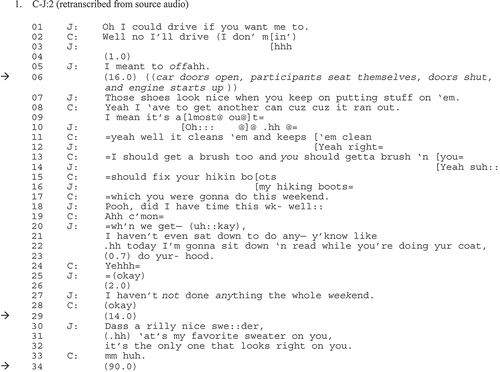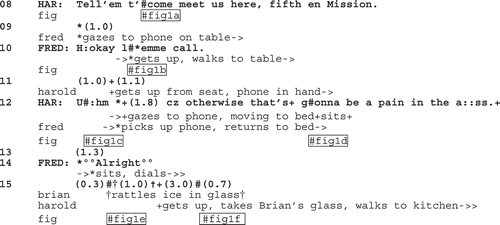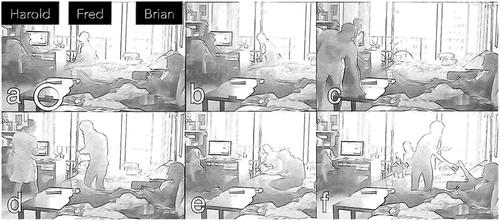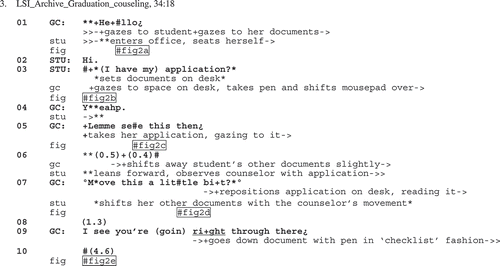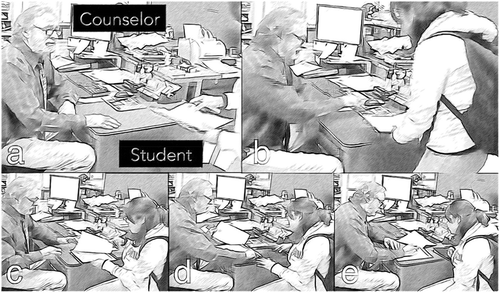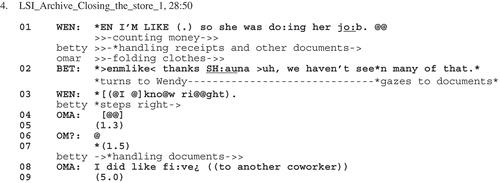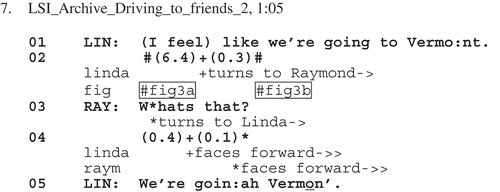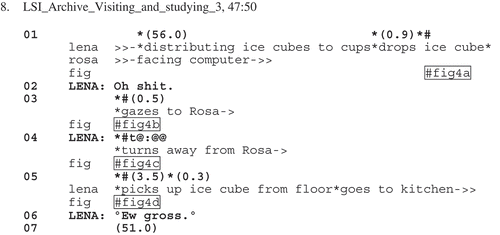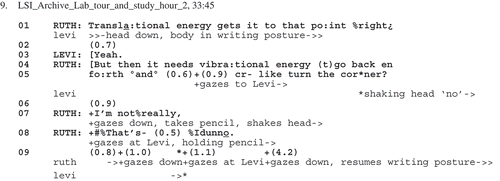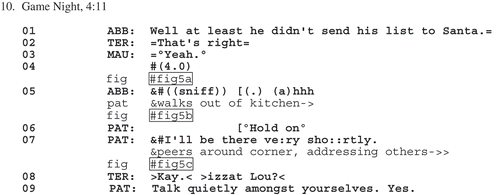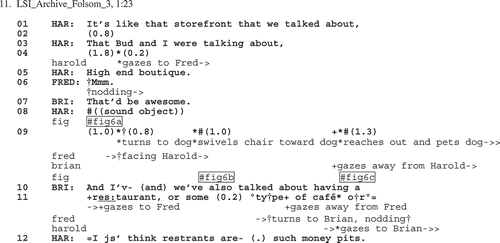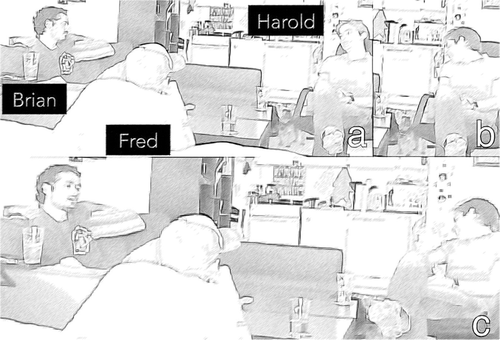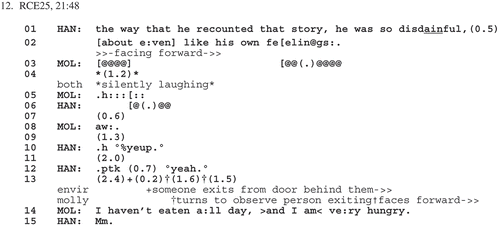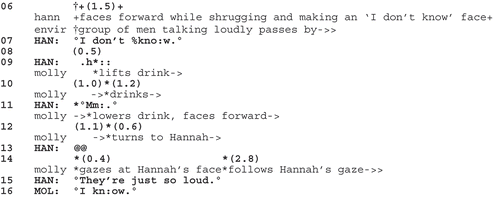Abstract
Interaction includes moments of silence. When all participants forgo the option to speak, the silence can be called a “lapse.” This article builds on existing work on lapses and other kinds of silences (gaps, pauses, and so on) to examine how participants reach a point where lapsing is a possibility and how they orient to the lapse that subsequently develops. Drawing from a wide range of activities and settings, I will show that participants may treat lapses as (a) the relevant cessation of talk, (b) the allowable development of silence, or (c) the conspicuous absence of talk. Data are in American and British English.
When people in a scene fall silent, the meaning of that silence depends on what went just before. This simple observation is at the heart of the “simplest systematics for the organization of turn-taking” identified by Sacks, Schegloff, and Jefferson (Citation1974) in the seminal article of conversation analysis. But although those researchers and others since have described many features of pauses and gaps in talk, much work remains to be done on other varieties of silence appearing in and around talk. In this article, I shall try and outline previous work on the subject, then offer some answers to questions that have so far remained unresolved about one particular kind of silence: the “lapse” that occurs when all participants forgo their turn to speak.
According to Sacks et al. (1974—hereafter referred to as “SSJ” for convenience), turn taking provides for discontinuous conversational interaction by giving participants the option to refrain from speaking when given the opportunity to do so—producing a lapse. Specifically, the current speaker may refrain from selecting a next speaker, all other parties may refrain from self-selection, and the current speaker may refrain from continuation. SSJ describe the resulting lapse as a period of nonspeech constituted by “rounds of possible self-selection” occurring at “certain classes of transition-places, characterizable by reference to the organization of sequences.” The authors illustrate this with the following example, in which Chris and Jean enter a car and drive off.Footnote1
Three lapses appear here (arrowed as in the original). The first occurs in line 6. While entering the car, Jean offers to drive (line 1). She prefaces this with the change-of-state token “oh” (Heritage, Citation1984a), which marks her offer as “just realized” and indexes the fact that she could have offered to drive earlier. Chris declines her offer and treats its late placement as unproblematic (line 2). This sequence ends with Jean acknowledging that her offer had come somewhat late (line 5). During this sequence-final turn, Jean doesn’t select a next speaker, and the subsequent silence indicates neither self-selection by Chris nor continuation by Jean. The rule set specified by SSJ is therefore exhausted, and a 16-s lapse develops. The same rules generate the other lapses (lines 29, 34): A course of talk-in-interaction reaches possible completion (Schegloff, Citation2007), and nobody self-selects despite the option for anyone to do so.
SOME UNRESOLVED MATTERS
This account, while specifying how discontinuous talk develops, leaves some matters unresolved. For instance, what, if anything, is observed during the lapse itself? What do “rounds of possible self-selection” actually look like? We can infer from the audio in Excerpt 1 that during the first lapse, Chris and Jean entered the car and started it up (line 6). But are all lapses understood by reference to some intervening activity? Another unresolved matter pertains to how lapses relate to gaps. Participants often do intricate interactional work to minimize the occurrence of gaps between turns, but the development of lapses clearly shows that this isn’t an omnirelevant task. What sort of circumstances, then, provide for the nonminimization of gaps and the subsequent development of lapses? By what practical procedures do participants enter and inhabit lapses? In short, how do participants arrive at a lapse and deal with its occurrence then and there? The analysis addresses these matters by showing how lapses come about and how they are treated by participants.
DATA
To survey lapses in a variety of situations, I sampled the videos commonly available in the Conversation Analysis research community, Leah Wingard’s Language and Social Interaction Archive (Citation2014), and Giovanni Rossi’s Corpus of English, collected in 2011. These corpora feature mostly American and British English and capture various activities across mundane and institutional settings. The recordings used for my collection of lapses feature, for instance, mealtimes, study sessions, board games, retail clothing stores, bicycle repair shops, car rides, food preparation, hanging out, and watching television. Informed consent was secured for the extracts and images used in this article. All identifying information has been anonymized, and most images have been obscured to preserve anonymity.
Selection of a Corpus
Lapses were located by following a generous interpretation of the description in SSJ, Citation1974 (pp. 714–715). Any silence was considered a candidate lapse if it developed due to the nonoperation of the turn-allocation techniques. So, silence is not a lapse if the current speaker selects a next speaker (C. Goodwin, Citation1981; Lerner, Citation2003; Schegloff, Citation2007; SSJ, Citation1974) or if any party indicates incipient speakership with some prebeginning behavior (Hoey, Citation2014; Mondada, Citation2007; SSJ; Schegloff, Citation1996; Streeck & Hartge, Citation1992). This excluded silences accompanying nonverbal responses (e.g., request > nonverbal compliance), since these cases typically feature speaker selection—or rather actor-selection (Sacks, Citation1992, p. 42). Silences appearing after so-called outloud utterances (Goffman, Citation1981) were included, however. Even though these do not appear to involve speaker selection, they nonetheless afford and often engender specifiable trajectories of action and forms of participation (Heath, Jirotka, Luff, & Hindmarsh, Citation1994, Heath, Sánchez Svensson, Hindmarsh, Luff, & Vom Lehn, Citation2002). This procedure generated a collection of 400+ lapses out of 22+ hr of video data.
The focus of this article is on situations where, after a given turn, there are what SSJ call “rounds of possible self-selection” that no one immediately takes up. Using conversation analytic methods (e.g., Sidnell & Stivers, Citation2013), I present cases where participants treat lapses as (a) the relevant cessation of talk, (b) the allowable development of silence, or (c) the conspicuous absence of talk. For each set of cases, I trace the sequential developments leading to a particular lapse and analyze participants’ orientations to it. I will try to show that “rounds of possible self-selection” are often accountable—that is, observable-and-reportable (Garfinkel, Citation1967)—by reference to the projectability of silence in and for a given activity and to the availability of engagements other than talk.
ANALYSIS
Lapses as the Relevant Cessation of Talk
As Szymanski (Citation1999) puts it, participants may “implicate the relevance” of lapsing out of talk-in-interaction. That is, they may signal that silence is the appropriate medium through which some now-relevant thing gets done. For instance, students may visibly “go on” with their classroom assignment as a way to implicate the relevance of stopping talk to resume their prior task (Szymanski, Citation1999). Lapses may also be implicated by interruptions like doorbells or telephone calls (Licoppe & Tuncer, Citation2014; Rae, Citation2001) or by practical incompatibilities between carrying on with talk and something else simultaneously (Keisanen, Rauniomaa, & Haddington, Citation2014). Building on these previous investigations, this section examines the interactional work required to transition from talk to copresent silence. It focuses on how participants arrive at a place where talk lapses and how they render that lapse as the relevant cessation of talk. Extract 2 shows two friends, Harold and Fred, working out the logistics of meeting up with Fred’s friends before they all go to a street fair later on. Another friend, Brian, is present but uninvolved.
In this interaction, Harold and Fred collaboratively project the relevance of “taking a phone call” as the next step in their joint project. Harold suggests that Fred tell his friends to come to Harold’s apartment, since that makes more logistical sense (lines 1–6). Fred accepts this suggestion (line 7). This acceptance projects a course of action whereby Fred should now call his friends to update them on their plan. “Making a phone call” is thereby established as the next-thing-to-do. Since “making a phone call” is an activity that typically affords a single copresent participant, cessation of talk and mutual disengagement from interaction are implicated. Harold and Fred both orient to this projected course of action: Harold tells Fred where his friends should come (lines 8–11), and Fred moves to retrieve his phone (-, circled). They depart from a face-to-face body configuration to attend to their phones (lines 9–12, –), marking the beginning of the lapse. The lapse is briefly interrupted by Harold, who gives another motivation for his suggestion (line 12), after which the lapse resumes as he goes to the kitchen to make Brian another drink (). Participants can thus collaboratively project the relevance of stopping talk to take up a next-positioned practical matter.
Lapses may be projected by participants, as shown in Extract 2, but they may also be projectable for a given activity. That is, lapses may be expected to occur by reference to an activity’s overall structural organization. The overall structural organization of some activity embraces the sequential ordering of that activity’s subcomponents and what gets done through them in that order (Levinson, Citation1992; Robinson, Citation2013; Schegloff, Citation2011). It includes all manner of conduct, including that which gets done in silence. Lapses may thus be expectable at specifiable junctures in the formal organization of an activity. This is seen in Extract 3, where an undergraduate student brings an application form to her meeting with the graduation counselor. Both participants orient to the relevance of lapsing out of talk as they move from the “greetings” phase to the “inspecting the application” phase of the encounter.
The student and counselor interactively constitute the student’s application form as central to their activity (Hazel & Mortensen, Citation2014), not only as a contentful object indicating the student’s progression toward graduation but also as a manipulable resource reflexively shaping their institutional encounter (Drew & Heritage, Citation1992). The counselor first orients to the potential relevance of the document by gazing at it while greeting the student (). The document then becomes consequential for the interaction as the counselor gazes at his desk and takes up his pen in preparation to handle it (). As he prepares his workspace for the document, the student also treats her application as relevant for their interaction by announcing that she has brought it with her (line 3). The counselor acknowledges her announcement (line 4) then concertedly attends to the document itself: He removes it from her stack of papers and pushes away the other documents she brought with her (lines 5–7, –). As he starts inspecting her application, the student adopts an “observing” posture: She leans forward and monitors his progress through her application (–).
The student and counselor have thus prepared their environment and positioned their bodies to begin the “inspecting the application” phase of their interaction. The participatory affordances of this phase permit the counselor to do “reading and checking” while the student does “observing and waiting.” This particular subcomponent of their interaction, in other words, favors silence. The lapse that develops (lines 8–10) is only briefly interrupted by the counselor’s initial assessment of her application. The overall structural organization of an activity may thus place the occurrence of silence in particular sequential positions. This is observed in participants’ treatment of the lapse as now-relevant for the development of their interaction—that is, in their moment-by-moment orientations to the document as a material resource facilitating a transition into silence.
Summary
These extracts highlight participants’ spatial-orientational configurations as foundational for the intelligibility of a given lapse. Since lapses are constituted by the absence of talk-in-interaction, order is produced and located via nonverbal channels. Important in this regard are notions from research on multimodality, like F-formation systems (Kendon, Citation1990), body torque (Schegloff, Citation1998), contextual configurations (C. Goodwin, Citation2000), and interactional space (Mondada, Citation2013). Concepts as these shed light on how participants enter and inhabit lapses. For instance, at the start of Extract 2, Harold and Fred are positioned face-to-face—an arrangement favoring mutual attention and closely coordinated action. But by the end of Extract 2, they have disengaged from that arrangement and pursue different activities in different sectors of their environment. What these participants are up to, that is, is observable through their “body idiom” (Goffman, Citation1963). The dynamic placement of bodies relative to one another in a particular setting, the flexible orientation of different body segments (eyes, head, torso, hands, and trunk), and the interaction of these with relevant features of the material environment provide an embodied contextual framework for the intelligibility of a given lapse.
Extracts 2–3 also show how participants collaboratively arrive at lapse-relevant places and how they render the subsequent lapse as the appropriate occurrence of silence. Participants were shown to project and orient to the relevance of silence through the mobilization of audible, visible, and material resources. These findings align with those of Szymanski (Citation1999) and Rae (Citation2001), among others. What this analysis adds is a specification of the stances that participants take up regarding the very relevance of talk in a place where it could lapse. For both extracts, talk-in-interaction was treated as instrumental for a given activity up to a point, whereupon it was then treated as unsuitable as the activity progressed. These stances are tied to the participatory affordances of activities like making a phone call and inspecting an application, which constrain the occurrence of talk-in-interaction. And so once these sorts of activities get established as the next-thing-to-do, then the relevance of lapsing out of talk becomes increasingly salient. “Rounds of possible self-selection,” then, may be understood as the appropriate cessation of talk in such situations. These cases contrast with those in the following section, where instead of being now-relevant, silence is treated as an ongoing relevant contingency.
Lapses as Allowable Silences
Some lapses are allowed to develop due to the ongoing relevance of other activities. The management of multiple courses of action and sites of involvement is characteristic of multiactivity settings (Haddington, Keisanen, Mondada, & Nevile, Citation2014). In such settings, participants are routinely presented with the choice to either proceed with talk or proceed with something else. This section shows cases where participants elect to proceed with “something else.” In Extract 4, three coworkers in a retail clothing store concurrently carry on a conversation and go about their individual duties related to closing the store.
While gossiping about another coworker (lines 1–6), Wendy counts money, Betty handles receipts, and Omar folds clothing. Their “gossiping” activity reaches a place of possible completion through shared affiliative laughter (Holt, Citation2010), after which their talk lapses (lines 7–9). The participants orient to this silence neither as a hitch in their shared activity of “closing the store” nor as a delay in their individual tasks comprising that overarching project. Rather, the lapse is treated as a place to simply go on with “closing the store,” only without talk: Wendy continues counting money, Becky proceeds with handling some documents, and Omar directs work-related talk to an off-camera coworker. By simply going on with their ongoing relevant activity, the participants treat the conclusion of talk and onset of silence as an unremarkable event, one that is largely inconsequential for the progressive development of “closing the store” (see Lerner, Citation1998). Two regimes of activity may thus be managed in parallel (Mondada, Citation2014), with one persisting as the other concludes.
Another setting where lapses are allowed to develop is during “watching television” (Berger, Citation2012). This is seen in Extract 5, where some family members watch a program about an Olympic athlete.
On-screen developments occasion an assessment by Paul, which is met with a downgraded second assessment by Caitlin. This assessment sequence concludes, and a lapse develops as they continue watching television. Extract 5 thus demonstrates that things like assessments can engender more talk in such settings (Ergül, Citation2014). However, this is not always the case. Participants watching television routinely issue assessments that receive no response, as in Extract 6. Here, the same family members watch a news report about a wave that injured beachgoers.
Paul’s running commentary provides opportunities for others to participate in talk-in-interaction. His coparticipants, however, do not respond. Silence emerges after each utterance (lines 2, 4), showing that things like assessments need not receive responses.
Extracts 5–6 provide a useful contrast regarding the places where lapses may occur. The description of lapses in SSJ (p. 715fn) suggests that lapses may only properly occur at sequence endings. This is the case for Extract 5, where a lapse develops after an assessment sequence. But this is not the case for Extract 6, where silences emerge after possible initiating actions. Though they occur in two sequentially distinct positions, I suggest that these silences are all lapses because participants treat them as the same kind of silence. During the silences in Extracts 5–6, the participants remain oriented to the television in their maintenance of a common focus (Kendon, Citation1988). These silences develop and are understood by reference to the ongoing relevance of “watching television.” These silences, as far as the participants are concerned, are cut from the same cloth. This commonality indicates that lapses may persist past opportunities to reengage in talk, meaning that lapses are not restricted to sequence endings but may occur in environments where participants have the option to speak but refrain from doing so.
The next extract lets us pursue a bit further the issue of where participants allow lapses to develop. Here, participants transform a lapse into a gap. This interaction takes place in a car, a perspicuous setting for the recurrence of lapses (M. H. Goodwin & Goodwin, 2012; Mondada, Citation2012; SSJ, Citation1974).
In line 1, Linda produces an inner-state announcement, possibly referring to the passing trees. Then, for 6.4 s, both she and Raymond remain completely stationary while gazing forward. The nonoccurrence of a response for this lengthy interval of silence, and the fact that this is apparently unproblematic, show the silence to be a lapse. The participants allow this lapse to develop by reference to the ongoing relevant activity of “driving/passengering” (Laurier et al., Citation2008). What then happens is, Linda turns to face Raymond (–), at which point talk promptly starts up (line 3). She transforms the lapse into a gap through her gaze pursuit; the silence is transformed from one of mutual disengagement from talk to one in which a response is now apparently expected.Footnote2
While Extract 7 shows how a lapse may become a gap, Extracts 8–9 show the inverse: gaps becoming lapses. These are cases where an incipient silence is first treated as a gap, with one participant orienting to further talk. This gap then becomes a lapse after both participants mutually orient away from the relevance of talk. In Extract 8, Rosa is working at her computer while Lena prepares drinks for the two of them.
Lena drops an ice cube while making them drinks, marking it with an “Oh shit” imprecation (lines 1–2). This “spill cry” (Goffman, Citation1981, p. 101) alerts Rosa to the possibility of trouble and creates an opening for prosocial intervention (Kendrick & Drew, Citationin press). Lena turns to Rosa immediately after her spill cry (–), thereby orienting to the appropriateness of some kind of reaction from Rosa. However, Rosa remains oriented to her computer (). The participants’ divergent analyses are thus seen in their bodily dispositions: Lena orienting to a potential reaction and Rosa showing that no reaction is necessary. Upon observing no reaction from Rosa, Lena laughs off the matter and attends to the dropped ice cube (lines 4–5, –). In doing so, she orients away from the possibility of joint action and aligns with Rosa regarding the relevance of talk then and there, transforming the gap into a lapse. This lapse is thus permitted to occur after some initial misalignment regarding the appropriateness of talk-in-interaction in that space.
Gaps may also become lapses at possible sequence completion. In Extract 9, Ruth and Levi are working on a chemistry assignment together. When reaching a place where talk could end, Ruth orients to the relevance of more talk, while Levi orients to continuing the assignment.
The transcript begins with Ruth asking Levi a question, which he answers with a minimal response (lines 1–3). Although Levi’s static writing posture projects resumption of their assignment (line 1), Ruth continues with her line of questioning (lines 4–5). Her second question is met with an even more minimal response from Levi, who simply shakes his head “no” (line 4–5). In light of his unresponsiveness, Ruth begins to move toward sequence closure: Bodily, she reorients to her work by taking her pencil, and verbally, she issues two claims of uncertainty, which work to neutralize the relevance of her project (Beach & Metzger, Citation1997; lines 7–8). During this time and in the silence that follows (lines 7–9), she gazes away, toward, away, toward, and finally away from Levi, visibly providing him an ample amount of opportunities to engage in talk. This negotiated transition from partial disengagement to mutual disengagement finally results in a state of silent copresence. Participants may thus pass through a gap before settling into a lapse.
Summary
In this section, when confronted with the option to continue with talk or lapse into silence, participants chose the latter. In Extracts 4–7, this movement into silent copresence was virtually unmarked, as participants simply continued doing what they were already accountably doing. And in Extracts 8–9, this decision required more negotiation, as participants were initially misaligned regarding the option to talk or lapse. Overall, participants used ongoing relevant alternative engagements as resources for shifting out of talk. For such multiactivity settings (Haddington et al., Citation2014), one practical concern is the mutual adjustment of talk relative to alternative engagements. The participatory affordances of activities like “working,” “studying,” “driving/passengering,” and “watching television” influence how lapses emerge in these settings. Activities like “studying,” for instance, afford the routine permissibility of lapses. Part of how one accountably participants in “studying,” in other words, includes orienting to the optionality of talk at a place where more talk could occur. In contrast to these multiactivity settings, lapses are managed quite differently in settings organized for just one activity (i.e., talk-in-interaction), as shown in the next section.
Lapses as the Conspicuous Absence of Talk
The lapses analyzed so far have been understandable by reference to now-relevant or ongoing relevant courses of action. But lapses can nevertheless appear without being projected to occur and may develop in settings where participants apparently have few alternative engagements to take up. These lapses occur within talk-in-interaction and may be treated as the conspicuous absence of talk—as silence where talk should be.Footnote3 A clear illustration of this appears next. Here, Maureen, Abby, and Terry are waiting to resume a board game while Pat takes a phone call in the kitchen. The transcript begins with some talk about Pat’s nephew.
Their talk about Pat’s nephew comes to possible completion (line 3) and then lapses into silence (lines 4–6). In response to the silence, Pat walks over to update them on the progress of her phone call (lines 5–7, –). The progress of her call is relevant because its ending would enable them to resume their board game. She also instructs them to “talk quietly amongst [themselves]” (lines 9). So, even though Pat had no part in the generation of the lapse, she nevertheless treats it as the conspicuous absence of talk and as requiring remediation.
This example demonstrates that some “rounds of possible self-selection” are understood as silence where talk should be. Such lapses come about by the coincidence of two structurally provided possibilities in talk-in-interaction. In the beginning of Extract 10, the participants are lodged in a state of sustained talk (Goffman, Citation1967, p. 34; Schegloff & Sacks, Citation1973), then arrive at possible sequence completion (line 3). The potential ending of a sequence of talk is a critical juncture because it provides the option to do something else (e.g., return to a prior matter, launch a new sequence, etc.) (Schegloff, Citation2007). At the same time, it is possible that no next-thing-to-talk-about awaits at sequence completion. This may coincide with participants electing not to self-select (SSJ), which is structurally provided by the turn-taking system. When this happens, we observe lapses like the one in Extract 10. So, lapses of this sort may develop if the turn-taking machinery yields no next speaker, and sequence organization furnishes no apparent next-thing-to-talk-about.Footnote4
Another feature of such lapses is the relatively static positioning of participants’ bodies. During the lapse in Extract 10, the participants remain in a spatial configuration that supports mutual attention and collaborative action (–). In approaching sequence completion, and for the duration of the lapse itself, they merely engage in minor disengagements like drinking, stretching, and face-touching (–; C. Goodwin, Citation1981, Citation1986). In other words, they do not recognizably take up some new course of action that would remove them from their present involvement and so remain visibly committed to carrying on with conversational activity. And indeed, the participants orient to the relevance of talk as soon as Pat enters and addresses them (lines 7–9). A clearer instance of how these disengagements work is shown in Extract 11. The transcript involves the same three friends seen in Extract 2, and starts with Harold describing a store he’s thought about opening up.
In describing the kind of business he’s considered starting, Harold encounters trouble with establishing recognition (lines 1–2). He first treats the trouble as one of referential specificity, disaggregating “we” into “Bud and I” (lines 1, 3; Lerner & Kitzinger, Citation2007). This fails to secure recognition, so Harold supplies the referent explicitly (lines 4–5), which succeeds in getting responses from his coparticipants (lines 6–7). Harold receipts their responses with a lipsmack sound object, which brings the sequence to closure, and marks the start of a lapse (lines 8–9). After 1 s of silence, Harold turns to the pet dog nearby (–). Then after 1.8 s of silence, he reaches out to pet it (–). Harold thus uses the dog as resource for disengaging from talk (Bergmann, Citation1988).
The placement of Harold’s disengagement in this sequential environment indicates its strategic use. During the silence at the beginning of line 9, Harold observes that neither of his coparticipants has chosen to self-select. Subsequently, rather than continuing his turn (SSJ), he disengages. By attending to something that is decidedly not talk, and by doing so in an environment where turn-transfer is relevant, Harold shows himself to be both ineligible and disinterested in speaking next. Another participant, Brian, shares this understanding of the disengagement as indicating “I will not speak”: After Harold disengages, Brian gazes away from him, then ends the lapse by extending the topic (lines 9–11, ). Finally, we may note that Harold promptly returns to talk once Brian ends the lapse (lines 11–12). This shows that his disengagement is avertable and implies no major change in the nature of their activity. Disengagements like this target a problem in speaker selection. In settings organized for sustained talk, lapses may be treated as the conspicuous absence of talk because they are silences without a next speaker. The problem, then, is arranging a place for a next speaker to appear. By disengaging from interaction, participants show themselves to be unlikely next speakers and leave it to the remaining participants to self-select.
Another method targeting the speaker selection problem in these lapses is sequence recompletion. Through sequence recompletion, participants reoccasion the relevance of sequence completion even after possible sequence closure was already reached (see Schegloff, Citation2009 on a similar device). This is seen in Extract 12, which involves Hannah and Molly chatting about a mutual acquaintance.
Their talk comes to possible completion as they laugh together affiliatively (Holt, Citation2010; lines 1–6). At this juncture, either participant may self-select and move onto something else. Rather than progressing to a next thing, though, both participants recomplete the sequence. Molly first produces an appreciative “aw:” (line 5), through which she marks her stance toward the story, treats the story as complete, and provides a place where Hannah could start up something else. What follows, however, is not the start of something else but the start of a lapse (line 9). Hannah curtails this lapse with a quiet “yeup” (line 10). With her “yeup,” she acknowledges Molly’s “aw:” and projects no further elaboration (Raymond, Citation2013). And by projecting no elaboration, Hannah displays no resistance to moving on and positions herself as a recipient to whatever talk Molly might produce next. After two more seconds of silence in which neither participant self-selects, Hannah indicates possible turn entry with “.ptk,” only to withdraw this claim to the turn-space with a soft “ºyeahº” (line 12).
This extract shows both participants passing up the option to speak at possible sequence closure. In the place where some prospective orientation is relevant (e.g., sequence initiation or expansion), participants instead display a distinctively retrospective orientation through their sequence recompleting tokens. These minimal tokens perform subtle interactional work (Gardner, Citation2001), and their placement in this sequential environment reveals their tactical utility. Jefferson (Citation1984) observed that in their selective distribution, not only can they “serve as indices of a participant’s current status vis-à-vis recipient and speakership, but can themselves be deployable devices with consequence for the shape of the interaction” (p. 17, emphasis original). Sequence recompleting tokens are a minimal “something” where “something” is due. On the one hand, they do the work of showing continued commitment to engaging in talk-in-interaction. And on the other, they defer the initiation of talk to another party. Phrased differently, sequence recompletion is a way to protract the process of bringing a sequence to closure (Schegloff, Citation2007). It shows interactants engaged in a game of turn-transfer hot potato, with each sequence-recompleting move sufficing as a minimal turn and furnishing the opportunity for some other party to self-select. Sequence recompletion is thus well fitted to the speaker-selection problem that such lapses present.
When participants treat a lapse as the conspicuous absence of talk, they are largely orienting to an uncertainty regarding who will speak next. Extracts 10–12 showed two methods for handling this speaker selection problem: disengagement and sequence recompletion. Both of these methods are observed in the following extract, as well as a third method: removing the relevance of a next speaker. This is done by transforming the lapse from a “problematic” one into an “allowable” one. Here, the same participants as in Extract 12, Hannah and Molly, are talking about a couple in their graduate program.
The transcript begins with Hannah remarking that the girlfriend receives funding for her research, while the boyfriend does not (lines 1–3). Molly laughs and gazes away in response (line 5), bringing the sequence to possible closure. Hannah ends the sequence by backing off her potentially threatening remarks with an embodied and verbal “I don’t know” (lines 6–7; Beach & Metzger, Citation1997). A lapse then begins to emerge (line 8). Molly treats this silence as the relevant place to disengage from talk by taking a drink (lines 9–10). Hannah similarly shows that she will not speak next by recompleting the sequence with a quiet “Mm” (line 11; Gardner, Citation2001; Jefferson, Citation1993). So, both treat the silence as the absence of talk.
The participants then transfigure the lapse from one in which “nobody is talking” to one where “now we’re doing something that doesn’t require talk.” This stepwise progression begins with Molly’s turn to Hannah (line 12). By turning to her, Molly both orients to the unoccupied “slot” for a next speaker and furnishes herself as “someone to speak to.” In response, rather than beginning a turn, Hannah laughs (line 13). This laughter prompts Molly to search for what occasioned it. She first looks to Hannah’s face, then follows Hannah’s gaze (line 14), locating at the end of it a group of men talking loudly (first audible in line 6). By gazing to this new site of focus, Molly joins Hannah in another activity, one that isn’t structured by talk-in-interaction. The reconfiguration of their embodied participation framework opens up a new activity that they may engage in: “observing loud passers-by.” By visually attending to the group of men, and by doing so together, they switch from “chatting” to “observing loud passers-by.” The lapse thus becomes one that is allowed to occur by reference to this newly available alternative engagement, rather than one characterized by problems in speaker selection.
Summary
Lapses can be problematic if they disrupt what should be an unbroken flow of talk, which can occur if the orders of turn taking and sequence yield no next speaker and no next-thing-to-do.Footnote5 This occurred in Extracts 10–13, which all took place in settings organized for sustained talk-in-interaction. During these lapses, participants displayed their orientations to the continued relevance of talk through the procedures of disengagement and sequence recompletion. Through disengagement, participants displayed an ineligibility and reluctance to speak next. Through sequence recompletion, participants actively deferred the opportunity to speak. It was also shown that participants could circumvent the speaker selection problem in these lapses by orienting to a newly established alternative engagement.
DISCUSSION
The general aim of this article was to bring lapses into focus and begin unearthing their organization. Accordingly, lapses from a range of social situations were examined with respect to how they came about and how participants treated them. The first section showed participants treating lapses as the relevant cessation of talk—as silence where silence should be. In these cases, participants prepared a place to lapse out of talk to attend to some now-relevant contingency, such as proceeding to a next step in a joint project or initiating the reason-for-the-interaction (Extracts 2–3). The following section showed participants treating lapses as the allowable development of silence—as silence where either talk or silence could be. In these cases, participants oriented to the optionality of talk. Some of these lapses were allowed to develop as participants simply went on with what they were already doing (Extracts 4–7), while others emerged only after some misalignment regarding the relevance of talk (Extracts 8–9). The final section showed participants treating lapses as the conspicuous absence of talk—as silence where talk should be. Participants in these cases faced the problem of locating a next speaker where none was immediately apparent. In dealing with this problem, participants shied away from speakership (Extracts 10, 11, 13), actively deferred it (Extracts 12–13), or neutralized the relevance of a next speaker entirely (Extract 13).
These findings contribute to our understanding of lapses by providing detailed descriptions of some of the pathways leading to environments where talk may lapse. In particular, they highlight the diversity of ways that participants may arrive at the possibility of a lapsing: Participants may project, anticipate, revert to, settle into, negotiate, or encounter a lapse.Footnote6 The findings also provide some account of what “rounds of possible self-selection” actually look like. Because lapses are constituted by nonspeech, of critical importance are participants’ spatial-orientational configurations, gaze distribution, and engagements with relevant features of the material world. This visible “body idiom” (Goffman, Citation1963) supplies an embodied interpretive framework for the recognizability of a scene and communicates what participants are accountably doing during a lapse. Major bodily realignments, for instance, can mark relatively lasting shifts in activity (Extracts 1–3, 8), while minor postural changes typically embody participants’ commitments to the same activities (Extracts 4–7, 9–13).
Inextricably tied to participants’ bodily conformations are the very circumstances in which they are enmeshed and the activities to which they are accountably committed (C. Goodwin, Citation2000). The reflexive relationship between an activity and its local production (Heritage, Citation1984b) is detectable through that activity’s participatory affordances (cf. Chemero, Citation2003; Gibson, Citation1979). Participatory affordances furnish the normative ways to participate in some activity and regulate the relevance of things like number of participants, material artifacts and surroundings, distribution of focus, bodily dispositions, and modality of participants’ contributions. Talk-in-interaction is afforded to different degrees at different times in different activities. It may be required, expected, tolerated, or prohibited for the discernible coherence of a given activity at a given moment. This is a particularly salient issue when faced with the possibility of a lapse. In these environments, participants may orient to participatory affordances for talk by treating talk itself as instrumental but inapposite (Extracts 2–3), appropriate but inconsequential (Extracts 4–5), ignorable (Extracts 6–8), permitted but interruptive (Extract 9), hearably absent (Extract 10), or relevant but stalled (Extracts 11–13). By taking up these various stances to the relevance of talk, participants facing the possibility of a lapse show themselves to be concerned with how talk itself features in the constitution and progressive realization of their activities.
To situate lapses in the scaffolding of interaction more generally, consider the fact that SSJ are explicitly concerned with turn taking for conversation and not necessarily the organization of talk in other realms of social life. This qualification implies that the turn-taking system, in its full-bore operation, may be inappropriate for organizing social settings where one-at-a-time talk with recurrent speaker change isn’t observed (Schegloff & Sacks, Citation1973). The turn-taking machinery, however, provides for the occurrence of lapses, and so it provides a way to transition into settings where talk isn’t the central activity. Lapses, seen in this way, offer the possibility to organize a social encounter through methodic procedures that are unrelated to turn taking. In particular, lapses present the possibility to moderate the relevance of turn-transfer, current/next speakers, gap minimization, and the like. Lapses occupy a privileged position in talk-in-interaction because they invite participants to display their understandings regarding the relevance of turn taking for organizing their current and/or next activity. They embody a prominent interface between turn taking as an organizational system and other collections of organizational practice.Footnote7
These considerations let us address the difficulties in distinguishing gaps from lapses. SSJ perhaps oversimplify the matter in characterizing gaps as “inter-turn” and lapses as “inter-sequence” (pp. 714–715). This formulation cannot address cases like Extracts 5–6, where silences are treated identically even though they appear in very different sequential environments. Further complicating the matter are silences treated as the conspicuous absence of talk (Extracts 10–13). These are gaplike insofar as participants orient to the relevance of talk, but lapselike in that the very thing participants are reacting to are “rounds of possible self-selection.” One way past this terminological impasse is implied in cases like Extracts 8–9. In these extracts, participants are misaligned regarding the relevance of talk in going forward—the silence is gaplike for one participant and lapselike for another. That is, participants may treat silence as embodying the relevance of more talk, in which case it is more gaplike, or they may treat it as embodying the relevance of some nontalk activity, in which case it is more lapselike. So although the analysis presented three “types” of lapses, these are better thought of as three semidistinct assemblages of practices for interactively rendering some possible lapse into a recognizable social object.
The topic of this article resonates with several notions about participation: open states of talk (Goffman, Citation1967), continuing states of incipient talk (Schegloff & Sacks, Citation1973), focused/unfocused interactions, main/side involvements, and dominant/subordinate involvements (Goffman, Citation1963). However intuitively sensible, these conceptualizations regarding talk, silence, and activity are essentially unexplicated (Berger, Citation2012). They rely on a kind of topographic perspective on talk and silence, where the borders between talk and silence are clearly discernible. Participants, however, are in the business of constructing the interactional landscape, not surveying it. When reaching a possible lapse, participants must assess the relevance of talk then and there as if “for another first time” (Garfinkel, Citation1967). By detailing how participants deal with such contingencies, this article shows how concepts like “continuing states of incipient talk” might be grounded in participants’ conduct.
Silence is an inescapable feature of social encounters of all kinds. This article examined an understudied form of silence: lapses. An account was provided for how participants reach places where talk lapses and how they constitute these “rounds of possible self-selection” as meaningful silences. The diversity of ways in which participants arrive at and account for lapses shows that they are not monolithic social objects. Rather, the import of a given lapse is interactively achieved and is sensitive to the structure of participants’ activities and the availability of alternative engagements. The consequentiality of a given lapse turns on participants’ calculations regarding the role of talk for their current projects and potential courses of action. In this way, lapses present a noteworthy site for examining how higher levels of structural organization reach into the local production of talk-and-other-conduct in interaction. This article thus respecifies the usage of talk itself as a pervasive concern for members in their management of everyday affairs and participation in the social world.
FUNDING
This work was supported by a PhD fellowship from the International Max Planck Research School for the Language Sciences.
Additional information
Funding
Notes
1 Departures from Jeffersonian transcription conventions include @ for laughter and % for creakiness. Visible behavior is transcribed following Mondada (e.g., Citation2014).
2 Another plausible analysis of Linda’s gaze pursuit is that it underscores the conditional relevance already present in her announcement (Couper-Kuhlen, Citation2010; see also Stivers & Rossano, Citation2010). Under this analysis, the entire silence would be a gap. I argue that because the interval of silence is so long and unproblematic, and because nothing else in the video accounts for it (e.g., something like changing lanes or adjusting the camera), participants understand this as a lapse for the span of its duration, and then only upon Linda’s pursuit does it become a gap.
3 The silences in this section hover somewhere between gaps and lapses. They are distinctively gaplike in that participants observably orient to the relevance of continued talk-in-interaction for the duration of their occurrence. At the same time, they are lapselike by virtue of occurring via rounds of possible selection. For this reason, they could called something like “growing gaps,” “incipient lapses,” or, vernacularly, “awkward silences.” I refer to them as lapses here not only for consistency but also because this is arguably another way that talk is discontinuous. The gap versus lapse issue is addressed more fully in the discussion.
4 The placement of lapses here differs from those in previous sections. The lapses in this section only come about at sequence closure, whereas other lapses can appear in places that are analyzably not sequence-final. For example, lapses occasioned by an interruption like a doorbell may appear in any sequential position. And lapses that develop after some utterance is not taken up (Extracts 6–8) arguably occur in (what would be) sequence-medial position.
5 There is clearly cross-cultural/linguistic variability in how members account for a given silence (e.g., Berger, Citation2011; Gardner & Mushin, Citation2015). My claim, however, is not about the universality of specific lapse behaviors but a more general one about the relationship between talk and the arenas of social life in which it appears. Though it remains to be seen, the issues engendered by lapses (what do we do now that nobody is talking? are we doing something together? what do we do next?) are likely generic enough such that members of different cultures might arrive at similar kinds of practiced solutions (Schegloff, Citation2006).
6 Some of these procedures recall what Schegloff and Sacks (Citation1973, p. 325) called “adjournments” from talk.
7 The forms that these other orders of organization might take are not as fully articulated as those for talk and sequentiality. Research on gesture and multimodality is fairly well developed (e.g., Hazel, Mortensen, & Rasmussen, Citation2014; Streeck, Goodwin, & Lebaron, Citation2011), and a vibrant line of research has extended CA methods and concerns to domains like multiple activities (Haddington et al., Citation2014), space (Hausendorf, Mondada, & Schmitt, Citation2012), mobility (Haddington, Mondada, & Nevile, Citation2013), and objects (Nevile, Haddington, Heinemann, & Rauniomaa, Citation2014). This is not to suggest a strict division between “activities organized by turn taking” and “activities organized by something else.” Rather, the turn-taking organization supplies a package of procedures, elements of which may be transposed à la carte to other spheres of activity (e.g., coordinating turn-construction with bodily vocal displays, Keevallik, Citation2014). Participants are promiscuous in their sense-making methods and apply the procedures they do for all practical purposes according to the constraints and affordances of a given moment.
REFERENCES
- Beach, W., & Metzger, T. (1997). Claiming insufficient knowledge. Human Communication Research, 23(4), 562–588. doi:10.1111/j.1468-2958.1997.tb00410.x
- Berger, I. (2011). Support and evidence for considering local contingencies in studying and transcribing silence in conversation. Pragmatics, 21(3), 291–306. doi:10.1075/prag.21.3.01ber
- Berger, I. (2012). Inaction and silent action in interaction ( Unpublished doctoral dissertation). University of Roehampton, London, England..
- Bergmann, J. (1988). Haustiere als kommunikative Ressourcen [Pets as communicative resources]. In H.-G. Soeffner (Ed.), Kultur und Alltag (pp. 299–312). Göttingen, Germany: Schwarz.
- Chemero, A. (2003). An outline of a theory of affordances. Ecological Psychology, 15(2), 181–195. doi:10.1207/S15326969ECO1502_5
- Couper-Kuhlen, E. (2010). Commentary on Stivers and Rossano: “Mobilizing Response.” Research on Language & Social Interaction, 43(1), 32–37. doi:10.1080/08351810903471316
- Drew, P., & Heritage, J. (Eds.). (1992). Talk at work. Cambridge, England: Cambridge University Press.
- Ergül, H. (2014). The organisation of watching television ( Unpublished doctoral dissertation). Newcastle University, Newcastle upon Tyne, England.
- Gardner, R. (2001). When listeners talk. Amsterdam, The Netherlands: John Benjamins.
- Gardner, R., & Mushin, I. (2015). Expanded transition spaces: The case of Garrwa. Frontiers in Psychology, 6, 251. doi:10.3389/fpsyg.2015.00251
- Garfinkel, H. (1967). Studies in ethnomethodology. Englewood Cliffs, NJ: Prentice-Hall.
- Gibson, J. J. (1979). The ecological approach to visual perception. Boston, MA: Houghton Mifflin.
- Goffman, E. (1963). Behavior in public places. New York, NY: The Free Press.
- Goffman, E. (1967). Interaction ritual. New York, NY: Doubleday.
- Goffman, E. (1981). Forms of talk. Philadelphia, PA: University of Pennsylvania Press.
- Goodwin, C. (1981). Conversational organization. London, England: Academic Press.
- Goodwin, C. (1986). Gestures as a resource for the organization of mutual orientation. Semiotica, 62(1–2), 29–49. doi:10.1515/semi.1986.62.1-2.29
- Goodwin, C. (2000). Action and embodiment within situated human interaction. Journal of Pragmatics, 32(10), 1489–1522. doi:10.1016/S0378-2166(99)00096-X
- Goodwin, M. H., & Goodwin, C. (2012). Car talk: Integrating texts, bodies, and changing landscapes. Semiotica, 191(1/4), 256–286.
- Haddington, P., Keisanen, T., Mondada, & L. Nevile, M. (Eds.). (2014). Beyond multitasking. Amsterdam, The Netherlands: John Benjamins.
- Haddington, P., Mondada, L., & Nevile, M. (Eds.). (2013). Interaction and mobility. Berlin, Germany: De Gruyter.
- Hausendorf, H., Mondada, L., & Schmitt, R. (Eds.). (2012). Raum als interaktive ressource [Space as an interactive resource]. Tübingen, Germany: Narr.
- Hazel, S., & Mortensen, K. (2014). Embodying the institution—Object manipulation in developing interaction in study counselling meetings. Journal of Pragmatics, 65, 10–29. doi:10.1016/j.pragma.2013.11.016
- Hazel, S., Mortensen, K., & Rasmussen, G. (Eds.). (2014). A body of resources—CA studies of social conduct. Special Issue. Journal of Pragmatics, 65.
- Heath, C. (1984). Talk and recipiency. In J. Heritage & J. Atkinson (Eds.), Structures of social action (pp. 247–265). Cambridge, England: Cambridge University Press.
- Heath, C., Jirotka, M., Luff, P., & Hindmarsh, J. (1994). Unpacking collaboration: The. Interactional Organisation of Trading in a City Dealing Room. Computer Supported Cooperative Work (CSCW), 3(2), 147–165. doi:10.1007/BF00773445
- Heath, C., Sánchez Svensson, M., Hindmarsh, J., Luff, P., & Vom Lehn, D. (2002). Configuring awareness. Computer Supported Cooperative Work (CSCW), 11, 317–347. doi:10.1023/A:1021247413718
- Heritage, J. (1984a). A change-of-state token and aspects of its sequential placement. In J. Atkinson & J. Heritage (Eds.), Structures of social action (pp. 299–345). Cambridge, England: Cambridge University Press.
- Heritage, J. (1984b). Garfinkel and ethnomethodology. Cambridge, England: Polity Press.
- Hoey, E. (2014). Sighing in interaction: Somatic, semiotic, and social. Research on Language and Social Interaction, 47(2), 175–200. doi:10.1080/08351813.2014.900229
- Holt, E. (2010). The last laugh: Shared laughter and topic termination. Journal of Pragmatics, 42(6), 1513–1525. doi:10.1016/j.pragma.2010.01.011
- Jefferson, G. (1984). Notes on a systematic deployment of the acknowledgement tokens “Yeah”; and “Mm Hm;.” Paper in Linguistics, 17(2), 197–216. doi:10.1080/08351818409389201
- Jefferson, G. (1993). Caveat speaker: Preliminary notes on recipient topic-shift implicature. Research on Language & Social Interaction, 26(1), 1–30. doi:10.1207/s15327973rlsi2601_1
- Keevallik, L. (2014). Turn organization and bodily-vocal demonstrations. Journal of Pragmatics, 65, 103–120. doi:10.1016/j.pragma.2014.01.008
- Keisanen, T., Rauniomaa, M., & Haddington, P. (2014). Suspending action: From simultaneous to consecutive ordering of multiple courses of action. In P. Haddington, T. Keisanen, L. Mondada, & M. Nevile (Eds.), Multiactivity in social interaction (pp. 109–136). Amsterdam, The Netherlands: John Benjamins.
- Kendon, A. (1988). Goffman’s approach to face-to-face interaction. In P. Drew & A. Wootton (Eds.), Erving Goffman (pp. 14–40). Cambridge, England: Polity Press.
- Kendon, A. (1990). Conducting interaction. Cambridge, England: Cambridge University Press.
- Kendrick, K. H., & Drew, P. (in press). Recruitment: Offers, requests, and the organization of assistance in interaction. Research on Language and Social Interaction.
- Language and Social Interaction Archive. (2014). San Francisco, CA: San Francisco State University. Retrieved from http://www.sfsu.edu/~lsi/
- Laurier, E., Lorimer, H., Brown, B., Jones, O., Juhlin, O., Noble, A., … Weilenmann, A. (2008). Driving and “passengering”: Notes on the ordinary organization of car travel. Mobilities, 3(1), 1–23. doi:10.1080/17450100701797273
- Lerner, G. H. (1998). Completable projects and winnable games: Notes on the organization of activity. Paper presented at the fourth annual Conference on Language, Interaction, and Culture, University of California, Los Angeles.
- Lerner, G. H. (2003). Selecting next speaker: The context sensitive operation of a context free organization. Language in Society, 32, 177–201. doi:10.1017/S004740450332202X
- Lerner, G. H., & Kitzinger, C. (2007). Extraction and aggregation in the repair of individual and collective self-reference. Discourse Studies, 9(4), 526–557. doi:10.1177/1461445607079165
- Levinson, S. (1992). Activity types and language. In P. Drew & J. Heritage (Eds.), Talk at work (pp. 66–100). Cambridge, England: Cambridge University Press.
- Licoppe, C., & Tuncer, S. (2014). Attending to a summons and putting other activities “on hold.” In P. Haddington, T. Keisanen, L. Mondada, & M. Nevile (Eds.), Multiactivity in social interaction (pp. 167–190). Amsterdam, The Netherlands: John Benjamins.
- Mondada, L. (2007). Multimodal resources for turn-taking: Pointing and the emergence of possible next speakers. Discourse Studies, 9(2), 194–225. doi:10.1177/1461445607075346
- Mondada, L. (2012). Talking and driving. Semiotica, 191(1/4), 223–256.
- Mondada, L. (2013). Interactional space and the study of embodied talk-in-interaction. In P. Auer, M. Hilpert, A. Stukenbrock, & B. Szmrecsanyi (Eds.), Space in language and linguistics (pp. 247–275). Berlin, Germany: De Gruyter.
- Mondada, L. (2014). The temporal orders of multiactivity. In P. Haddington, T. Keisanen, L. Mondada, & M. Nevile (Eds.), Multiactivity in social interaction (pp. 3–32). Amsterdam, The Netherlands: John Benjamins.
- Nevile, M., Haddington, P., Heinemann, T., & Rauniomaa, M. (Eds.). (2014). Interacting with objects. Amsterdam, The Netherlands: John Benjamins.
- Rae, J. (2001). Organizing participation in interaction. Research on Language and Social Interaction, 34(2), 253–278.
- Raymond, G. (2013). At the intersection of turn and sequence organization. In B. Szczepek-Reed & G. Raymond (Eds.), Units of talk—units of action (pp. 169–206). Amsterdam, The Netherlands: John Benjamins.
- Robinson, J. (2013). Overall structural organization. In J. Sidnell & T. Stivers (Eds.), The handbook of conversation analysis (pp. 257–280). Malden, MA: Wiley-Blackwell.
- Rossi, G. (2011). The Rossi Corpus of English. Nijmegen, The Netherlands: Max Planck Institute for Psycholinguistics.
- Sacks, H. (1992). Lectures on conversation (vol. 2). Oxford, England: Blackwell.
- Sacks, H., Schegloff, E. A., & Jefferson, G. (1974). A simplest systematics for the organization of turn-taking for conversation. Language, 50(4), 696–735. doi:10.1353/lan.1974.0010
- Schegloff, E. A. (1996). Turn organization: One intersection of grammar and interaction. In E. Ochs, E. A. Schegloff, & S. A. Thompson (Eds.), Interaction and grammar (pp. 52–153). Cambridge, England: Cambridge University Press.
- Schegloff, E. A. (1998). Body torque. Social Research, 65, 535–596.
- Schegloff, E. A. (2006). Interaction: The infrastructure for social institutions, the natural ecological niche for language, and the arena in which culture is enacted. In N. Enfield & S. Levinson (Eds.), Roots of human sociality (pp. 70–96). Oxford, England: Berg.
- Schegloff, E. A. (2007). Sequence organization in interaction. Cambridge, England: Cambridge University Press.
- Schegloff, E. A. (2009). A practice for (re-)exiting a sequence. In B. Frase & K. Turner (Eds.), Language in life, and a life in language (pp. 365–374). Bingley, England: Emerald.
- Schegloff, E. A. (2011). Word repeats as unit ends. Discourse Studies, 13(3), 367–380. doi:10.1177/1461445611402749
- Schegloff, E. A., & Sacks, H. (1973). Opening up closings. Semiotica, 8, 289–327. doi:10.1515/semi.1973.8.4.289
- Sidnell, J., & Stivers, T. (Eds.). (2013). The handbook of conversation analysis. Malden, MA: Wiley-Blackwell.
- Stivers, T., & Rossano, F. (2010). Mobilizing response. Research on Language & Social Interaction, 43(1), 3–31. doi:10.1080/08351810903471258
- Streeck, J., Goodwin, C., & Lebaron, C. (Eds.). (2011). Embodied interaction: Language and body in the material world. Cambridge, England: Cambridge University Press.
- Streeck, J., & Hartge, U. (1992). Previews: Gestures at the transition place. In P. Auer & A. Di Luzio (Eds.), The contextualization of language (pp. 135–157). Amsterdam, The Netherlands: John Benjamins.
- Szymanski, M. (1999). Re-engaging and dis-engaging talk in activity. Language in Society, 28(1), 1–23. doi:10.1017/S0047404599001013

